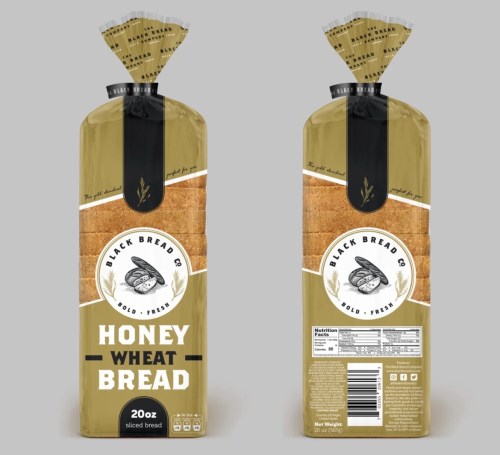Our editors independently select these products. Making a purchase through our links may earn Well+Good a commission
An RD Separates Fact From Fiction About the Nutritional Value of Bread (and Shares Why We Should Be Eating More of It)
A registered dietitian busts the most common myths about bread, giving the straight nutrition facts about bread. Plus brands to try.
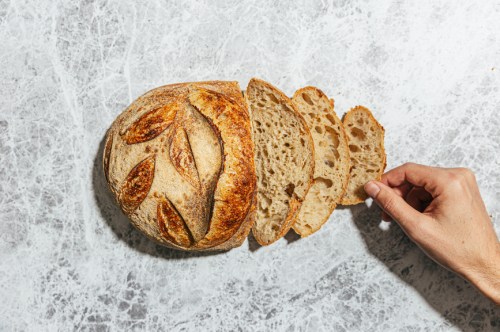
There are certain foods that virtually everyone in the wellness world fawns over. Tell a room full of health-conscious eaters that there are free collagen-spiked smoothies up for grabs and you better be ready for a leggings-clad stampede.
Experts in This Article
Alexis Newman is a registered dietitian based in Philadelphia.
Bread is not one of those foods. It’s often seen as the enemy of healthy eating to the extent that avocado, at times, has been considered an acceptable replacement for burger buns, mushy imprints and green-covered fingers be damned. But before you send the bread basket back with the waiter at your next meal, there’s something registered dietitians want you to know. Bread is actually healthy. In fact, it’s a core food in the Mediterranean diet (the most scientifically-backed way of eating to living a long, healthy life) and in some countries known to be longevity hotspots, like Ikaria, Greece.
The idea that bread has no nutritional value at all is a huge myth and registered dietitian Alexis Newman, RD, says it’s just one surrounding the food. But now, she’s setting the record straight once and for all on the nutrition facts about bread, separating fact from fiction on the most common misconceptions. Plus, she gives her dietitian-approved tips on how to buy the most nutrient-rich loaf possible.
5 bread myths an RD wants everyone to stop believing
Myth 1: Bread has no nutrient value
Let’s get straight to the biggest myth of all. “All bread has some nutritional value,” Newman says. Yep, that includes a thick slice of white bread. “All bread has carbohydrates, which is the body’s preferred source of energy.” Newman emphasizes that there is no need to fear carbs; they are a nutrient. She explains that carbs work their way into the bloodstream faster than protein and fats, making them ideal for quick energy. You still need protein and healthy fats in your life too, but carbs still do have value.
Besides carbs, Newman says that bread has other minerals and nutrients as well, which vary in type and amount depending on what kind of bread you’re going for. (More on that coming up.) “For example, white bread is often fortified with folate and other vitamins and minerals,” she says. “And certain types of bread, like whole grain, are high in fiber.”
Myth 2: Whole grain and whole wheat are the same
When you do decide to buy some bread, the options are…a lot. This can make figuring out which loaf to go for confusing. For example, ever wonder if there’s a difference between whole grain and whole wheat? There is. “The difference is that whole grain bread contains the whole grain—which can be barley, oats, sorghum, buckwheat, or wheat—and whole wheat bread only is made from wheat,” Newman explains.
Both, she says, have nutritional benefits. Whole wheat bread contains fiber, iron, and vitamin B6. Newman says whole grain bread also has fiber and additional minerals like B vitamins, iron, and magnesium.
See the difference? Now you’re ready for the bonus bread level: Understanding how multigrain bread is different from whole grain and whole wheat. “Multigrain bread is made with two or more types of grains, as opposed to whole wheat, which is solely wheat, or whole grain, which is made with one type of whole grain,” Newman says. She explains that the benefit to multigrain bread is that you’re getting a wider range of nutritional benefits because there’s a wider range of grains in it. Makes sense, right?
Myth 3: Bread is bad for the gut
If your bread has fiber in it (and almost all types have at least a little), it’s already making your digestive system happy. But Newman says there is one type of bread that is really good for your gut. “Sourdough bread is fermented, so it has probiotics, which are good bacteria that support the gut,” she says. (If you didn’t already learn that first-hand making it during year one of the pandemic, now you know.) “It’s also easier to digest than some other types of bread, which can be good for people with sensitive stomachs,” she says. So unless you have a gluten sensitivity or allergy, bread is not bad for your gut, and can, in fact, be beneficial.
Myth 4: Bread is bad news for blood sugar—period
“A lot of people are concerned about how eating bread will affect their blood sugar, particularly people who are diabetic or prediabetic,” Newman says. It’s true that if you are prediabetic or diabetic, you do have to be more conscious than the average person of foods that can spike blood sugar, which does include white bread. But Newman says there are types of bread these individuals can still enjoy.
“Ezekial bread, which is a type of sprouted bread, is one type of bread that doesn’t spike blood sugar levels as much as traditional white bread,” she says. “With this bread, the grain grows until it actually sprouts before being used to make the bread,” Newman explains. She adds that multigrain bread is another great choice because the protein and fiber balance out the sugar from the carbs, making a spike less pronounced.
Myth 5: Bread is better with the crusts cut off
Bread crusts are either tolerated or discarded completely. But there’s good reason not to go crustless. “While there’s debate whether the crust is actually more nutrient-rich than the rest of bread or not, what we do know is that it does contain nutrient value,” Newman says. The same nutrients in the fluffy part of the bread are also found in the crust. So eat the whole darn slice.
How to buy bread like an RD
When it comes to buying any food, what’s most important to keep in mind is taste. If you don’t like the texture of multigrain bread, don’t force yourself to buy it when you’d rather have a slice of sourdough. Otherwise, there’s a good chance that half the loaf is going to end up in the trash instead of your mouth. Simply liking the taste of something is reason enough to buy it.
That said, not all bread is considered equal on the nutritional front. Newman says if you want to buy the most nutrient-rich bread possible, high-fiber breads like sprouted bread, multigrain, or whole grain bread, are your best bet. She also recommends checking the sodium and sugar intake—some brands like to sneak in salt and sugar.
Don’t have time to do your label reading? Go for one of the breads rounded up here, which are high in nutrients and void of any fillers.
Food For Life Flourless Sprouted 100% Whole Grain Bread — $6.00
Made with sprouted wheat, each slice of this bread packs four grams of protein, three grams of fiber, and 80 milligrams of potassium.
Dave's Killer Bread Powerseed Organic Bread — $6.00
Besides organic whole wheat, this loaf is made with flaxseeds, sunflower seeds, pumpkin seeds, black sesame seeds, and rolled oats—that’s a lot of fiber-rich goodness. Each slice has five grams of protein and four grams of fiber.
Black Bread Co Honey Wheat Bread (2 pack) — $8.00
This subtly sweet white bread is fortified, so you’re getting iron and folic acid in every slice. Each serving has three grams of protein, too.
Bread Alone Sourdough Bread — $6.00
Want to stock up on the bread that’s especially good for the gut? This sourdough bread is full of probiotics which will make your digestive system extra happy.
Mestemacher Organic Sunflower Seed Bread — $18.00
This is the densest, highest fiber bread on the list, with six grams of the nutrient per serving. The ingredients list is just six simple ingredients: organic whole kernel rye, water, organic whole rye flour, organic sunflower seeds, sea salt, and yeast.
5 ways to use your bread
Have your bread? Here are some easy ways to incorporate it into your meals at home.
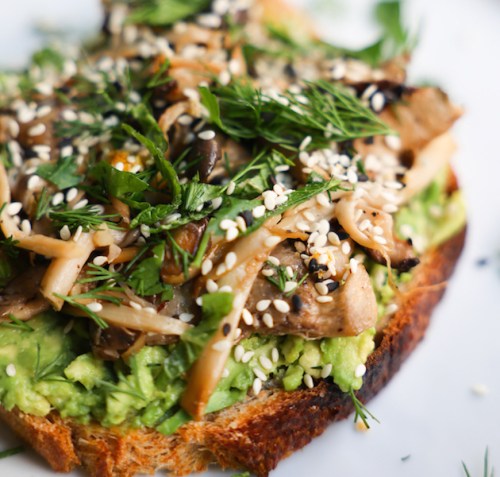
1. Wild mushroom avocado toast
There’s avocado toast and then there’s this. In addition to avocado, you’ll find garlic-seasoned wild mushrooms and olive oil topped on a thick slice of sourdough bread.
Get the recipe: wild mushroom avocado toast

2. Vegan grilled cheese
Warm rye bread, ooey gooey vegan cheese, homemade spinach “cream cheese”? You’ll be drooling as you make it. Good thing it only takes 10 minutes to whip up!
Get the recipe: vegan grilled cheese
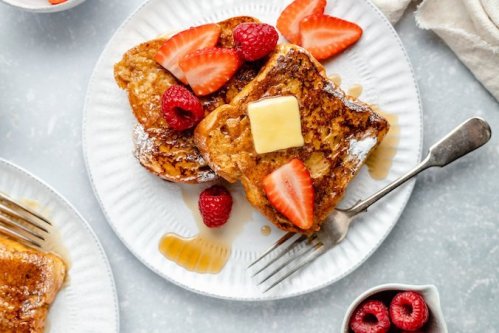
3. Dairy-free French toast
Having the right bread for French toast is key. The secret is using thick-slice bread. (This recipe uses thick sprouted, whole grain bread in particular.) Coconut milk, cinnamon, and almond extract give this breakfast layered sweetness without incorporating white sugar.
Get the recipe: dairy-free French toast
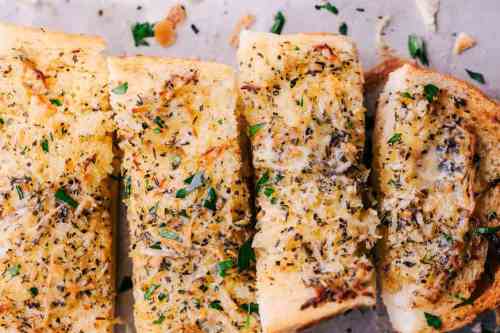
4. Garlic bread
Garlic helps support the immune system, brain health, heart health, and the liver—not a bad food to pair with your bread, right? If you need a simple recipe to use as a guide, this one has your back.
Get the recipe: garlic bread
Watch the video below to learn more about the health benefits of garlic:
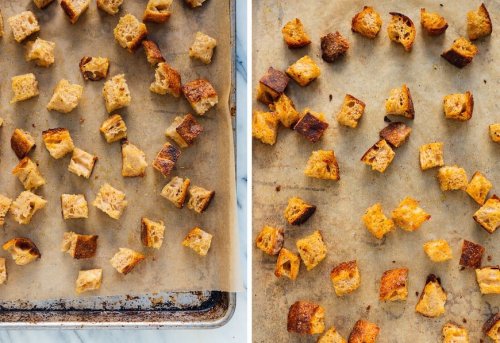
5. Homemade croutons
If your beloved bread has gone a little stale before you’ve gotten the chance to eat it all, don’t throw it out; it’s perfect for using to make croutons. Follow this recipe for an easy way to do it with just a few pantry staples.
Get the recipe: homemade croutons
There are so many reasons to celebrate bread, from how it tastes and what you can make with it to its nutritional profile. “The only bread I don’t recommend is moldy bread,” Newman says. Now that you have an RD’s sign-off, go forth, eat bread, and be merry. After all, there’s no reason not to.
Sign up for the Well+Good SHOP Newsletter
Get exclusive deals on wellness, beauty, fitness, and food products that have been hand-picked by our editors.
Got it, you've been added to our email list.





